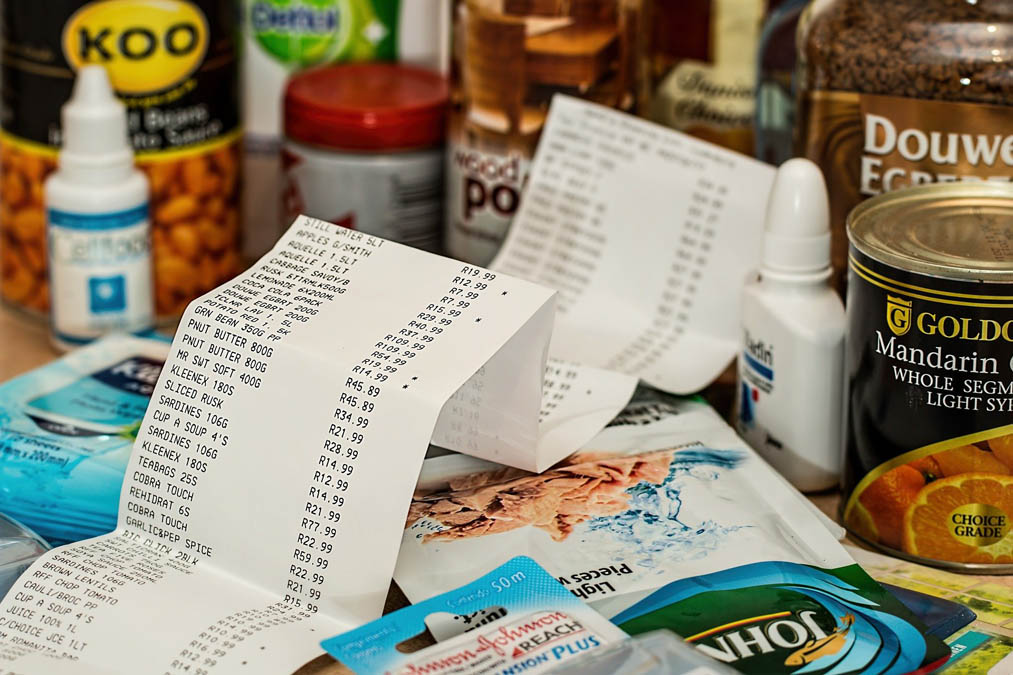At A Glance – Groceries can be a real budget buster. Here are 15 ways to save money on your groceries.
Food is one of the essentials of life. We have to eat. And food is considered one of the BIG 3 in any budget. Those three are Housing, Transportation, and Food.
Groceries can be one of your largest monthly expenses, so it’s important to save money with every frugal tip you can find.
Tips For Before You Shop
1. Make A Plan And A List…Then Stick To It
This is my top tip to save money on your groceries. Make a meal plan and grocery list before you leave the house. When you get to the store, stick to the list. Don’t give yourself any room for budget-breaking surprises. If you go shopping as a family, let your kids help plan the meals and find the items (it’s like a grocery store scavenger hunt!). It’s much easier to stay on budget when you’re shopping with a plan and working as a team.
2. Look In The Pantry First
This is an overlooked tactic, but a great one to help save money on your groceries. Challenge yourself to check through your pantry and fridge to see what meals you can put together with what you already have. Better yet, set up a 30-day challenge to use what’s in your pantry and only buy the essentials like milk and produce. You probably have items you’ve forgotten were there or are about to expire.
3. Know When To Shop
Many grocery stores start the new ads on Wednesdays and some stores will honor both last week’s and this week’s prices on Wednesdays. Check if your store does this.
Time of day plays a big role with bargains too. The early bird gets to hit the clearance shelves first! Find the section in your grocery store where the clearance items are. There may be separate clearance areas for produce, meat, and non-perishables. Find out what time of day those items are put on the clearance shelves.
4. Leave The Overspenders At Home
If you find that your kids are the ones adding all those not-on-the-list items to your cart, you might want to leave them at home. Yes, we’re looking at you with the bag of chips, Suzie. Or maybe it’s your spouse who needs to stay far, far away from the grocery store!
5. Check The Ads As You Make Your Meal Plan
Check your grocery store’s ads as you make that week’s meal plan. Buy items on sale whenever possible.
[convertkit form=1993750]
Tips For While You Shop
1. Don’t Shop When You’re Hungry
I’m sure you’ve heard this before and it’s true. We do crazy things when we’re hungry. “Please step away from the family-size pack of Little Debbies!” For me, it’s the junk food at the check-out. If I’m hungry, I feel I need to reward myself with a bag of chips or a candy bar.
So grocery shop on a full stomach!
2. Use Your Calculator While You Shop
If you keep a running tally of how much money is in your cart, you’ll save yourself from any surprises when you get up to the checkout line. Pull out the calculator on your phone and keep track of everything you’re putting in your cart. This might make you stop and ask yourself if you really need that fancy $5 sparkling water that isn’t on sale?
3. Buy In Bulk – Or Not
Many items are cheaper if you buy them in bulk. Especially at a big box store like Sam’s or Costco. The key to shopping at these stores is to know your unit price. Is the 35-roll pack of toilet paper really cheaper than the 12-roll pack at the grocery store? Maybe, maybe not. You need to know your unit price at both stores to decide.
Also, don’t assume the larger container of an item is cheaper without checking the unit price. The price per ounce on the smaller box of cereal is sometimes cheaper than the larger one sitting next to it. Use the calculator on your phone or check the per ounce price on the shelf sticker. (Beware, I’ve found the stickers aren’t always correct.)
Pro Tip: When freezing items bought in bulk, freeze them as flat as possible. They will thaw in a shorter time and you can remove individual pieces without thawing the whole container. For example, I split up a large package of ground turkey into one-pound portions and freeze in ziplocks. Flatten the meat and squeeze out the air. Then you have a flat package to stack in the freezer. Other items like fruit or pork chops can be pulled apart while still frozen so you don’t thaw the whole ziplock bag full.
4. Use Cash
I know many people use credit cards for the rewards points, but you can save money by using cash at the grocery store. When you buy with a credit or debit card you don’t feel the pain of the purchase. You feel the emotional consequences of handing over a Ben Franklin or two! It makes you think about what you have in your cart!
5. Use Curbside Pickup
This can save you time and money. Most stores are not charging an extra fee for curbside pickup. Order your groceries online from home and pick them up at your convenience. You will not be tempted to “graze” through the store and buy budget-breaking items, plus you can check your pantry as you order.
This is a great way for moms of young kids to shop without losing your mind or your patience!
6. Shop In Season
Fruits and veggies are available year-round in our grocery stores, but we pay a premium to buy out-of-season items. Strawberries can be twice the price in the winter or oranges and apples don’t taste so great right before the new crop comes in. Buy in season for the best deals.
7. Try Different Grocery Stores
I know that spending hours going to different stores is not your idea of a good time! But if it’s possible, shop different stores. When I lived in Texas, I had Kroger, HEB, Sprouts, Walmart, and Aldi within minutes. I learned who had the best price on what kinds of items. I would use the ads to plan which stores to shop for that week’s groceries. Time may not allow you to do this on a regular basis, but try it a few times until you learn the layout and items stocked in each store.
8. Learn The Sales Cycles
Most true grocery stores run their ads in cycles. Six, nine, or 12-week cycles. Find out if your store does this and plan your menus accordingly. If you know that frozen veggies will be on sale this week, you can plan to make a few batches of soup or pot pie for the freezer.
9. Don’t Buy More Than You Need
Everybody loves a sale! But if you buy something you don’t need, you’re not saving money. Don’t buy just because it’s on sale or you have a coupon.
Pro Tip: If an item is marked 5 for $10, you don’t normally have to buy all 5. My experience is most times you don’t. Read the shelf tag carefully. It will tell you if buying a single item is a different price. And watch those items when you check out to make sure they ring up correctly.
10. Buy Generic
I know…you have to have the name-brand ice cream! But, generic or store brands are cheaper than name brands. For me, I’m fine with generics for most things I buy. Give the store brands a try. You can save money on the ones that don’t matter to your family and splurge on items that really make a difference.
11. Convenience or Junk Food and Pre-packaged Food
Convenience and junk food will really add up fast. A snack-size bag of chips can cost the same as a full-size bag. You could buy a six-pack of soda or water for the same cost as buying a single at a convenience store. Anything pre-packaged or convenience will be more expensive – ground beef vs hamburger patties, pre-sliced apples vs whole, or baby carrots vs, whole carrots.
12. Don’t Buy Toiletries At The Grocery Store
You will almost always pay more for toiletries at the grocery store. Shop for these at stores like Target or Walmart or order online.
13. Get A Rain Check
If an item that is on sale sells out, ask for a raincheck.
14. Watch The Cash Register Monitor As You Check Out
Watch the cash register monitor or check your receipt to make sure all sale items rang up correctly. Some stores will even give you the item for free if the register is wrong. Or maybe you forgot to put your loyalty number in. Either way, it’s a good idea to check.15. Price Match
Some stores like Walmart will price match with other local stores’ ads. You need to have the ad with you to show the price. Also, the item will need to be sold in the same units, like per pound or per each.
Tips For After You’ve Shopped
1. Batch Cook And Cook Ahead
This can save you time and money! Buy ingredients for your favorite recipes in bulk when you find them on sale. Take a Saturday, batch cook, and freeze the meals to use in the next few weeks. Or make freezer bags with your raw ingredients to pop in the crockpot or Instant Pot. You can find recipes at The Family Freezer and other websites for freeze-ahead meals. Or just use your family’s favorite dishes. Most meals will freeze for later use.
Examples of what I batch cook and freeze are Spaghetti sauce (using the large $3.00 can of tomato sauce from Sam’s), any type of Mexican casserole, Chili, Tortilla or Vegetable soup, Taco meat, Chicken Pot Pie, and Meatloaf.
Be sure to research the proper containers and methods to freeze food for the best results. Here is the Taste of Home Guide to freezing food.
Pro Tip: When you cook a casserole to freeze for later, line the pan with foil and cook according to directions. Then freeze the casserole in the pan. When frozen solid, remove the food and wrap it well for freezer storage. Then you get your pan back! When you are ready to reheat, pop it back in the pan it was originally cooked in.
2. Use Your Leftovers!
I’ve heard many people say “My family won’t eat leftovers.” I’m sorry, but that’s just silly. I can’t imagine cooking a new meal from scratch every day! OK, enough of my rant.
Even now that there are just two of us at home, I still cook large batches or full casseroles and either freeze the leftovers for another day or for lunches. Buy containers that will hold individual servings and take your lunch to work. BIG SAVINGS. Freeze leftovers servings of a casserole for another meal. (Be sure NOT to refreeze a meal that has already been frozen and thawed once.)
3. If You Buy it – Use It
There’s nothing worse than finding half a container of yogurt that has gone bad. And you’re throwing away money when it goes in the trash. Do your best to use what you buy. If you have fruits or veggies getting soft, freeze them for smoothies or make soup. If you are making a recipe that calls for half of a container of greek yogurt, find another recipe for the week that will use the other half.
4. Eat Leftovers For Lunch
Going out to lunch can be a real budget-buster! If you go out twice a week at $10-15 a lunch, that adds up to $80-120 a month. That would take a big chunk out of my personal food budget and not leave me much for a nice dinner out. You can save a ton of money by bringing your lunch to work. And I bet you won’t be the only one.5. Store Produce Correctly So That It Will Last Longer
Look up online how to best store fruits and veggies so that they will last longer. For example, even though the peels of a banana will turn dark, they will last longer if you store them in the fridge.
Miscellaneous Savings Tips
1. Simplify Dinners
Dinner is your most expensive meal of the day. Look at how you can simplify to cut costs (and time). You don’t need a three-course meal every day. Try sandwiches, omelets, or a big salad a few times a week. Kids think breakfast for dinner is cool and eggs are cheap. One of my favorite dinners as a kid was bacon and eggs with biscuits. You can try frittatas or quiches for something a little fancier. I chop enough veggies for several salads and store them in plastic containers. That way I can make a salad for dinner in minutes.2. Try Going Meatless For A Meal
Meatless Monday, here we come! Don’t be afraid to branch out and go meatless once or twice a week. I’m not suggesting you need to turn vegan, but meat can be an expensive part of your grocery budget. Lookup a few meatless recipes and give them a try.3. If You Run Out Of Something Before Your Next Grocery Store Trip, Make Do Without It
Keep a few shelf-stable items on hand, like powdered milk, that can be used in recipes in case you run out. Substitute or omit items when you run out rather than making another trip to the store. Over time, you will become better at meal planning and checking the pantry and should rarely run out of the things you use most.4. Know The Best Bang For Your Food Buck
One way to stretch your food dollar is with items like beans, pasta, rice, potatoes, and whole grains. These items make an excellent side dish or main event. I cook beans, rice, or other whole grains in my Instant Pot and then freeze portions for use later.5. Cut Down On Soda, Fruit Juice, and Alcohol
I’m not saying you can’t have your favorite brew or a soda, but they do add up! Fruit juice has lots of added sugar and soda and alcohol are empty calories. Substituting water is the best for your health and your wallet, but I have to admit, I don’t like drinking plain water. I make plain carbonated water with a Soda Stream and add it to my juice, soda or sugar-free drink powder.6. Make Your Own Seasonings
Make your own taco, chili, spaghetti seasoning, and so on. You probably have all the ingredients on hand and you can google a recipe. Using your own spices is much cheaper and you won’t have random packets of taco mix hanging out in the back of your pantry from last year.7. Buy Holiday And Seasonal Items After the Holiday
Items such as candy, decorations, and wrapping paper will be drastically reduced after the holiday. Check stores like Walmart, Target, Hobby Lobby, and Michaels for after-the-holiday-deals. I try to buy all my Christmas wrapping after Christmas for the next year and store it in a closet.8. Start Or Join A Produce Or Meat Coop
This is something I’ve done several times in the past. I’ve belonged to a produce coop as a participant and as the “owner” where I did all the shopping.
One coop I belonged to had 12 members where a different pair of members would shop every 2 weeks. That way you only shopped once in a 12-week cycle. The price for the coop was set ahead of time, say $20 or $40 per person, whatever the members agreed to. Then that week’s shoppers would look for the best deals they could find. They would divide the goods into boxes or bags for the 12 members to pick up at the end of the day.
Another coop was one that I started, ran, and did all the work for. My participation averaged 12-18 people. It took me all day, but I wasn’t working and the benefits were great.
I charged $20/person (this was several years ago). I shopped sales at grocery stores if they had something I wanted and then went to the farmer’s market. With that many people, I could buy cases of items. Lettuce, squash, bell peppers, bananas, apples, etc. The prices per case were so much better than normal, so each person could get more for their $20 than was possible in the store.
My goal was to have 20 different items in the box. An item could be one head of lettuce or five apples. The perk for me was I got mine plus extra for free. I would pick up items I personally wanted that I didn’t buy for the others. For example, I might buy myself a watermelon or strawberries or asparagus when I didn’t buy it for anyone else. I traded my sweat equity for more produce. And I kept enough money out to pay for my gas. Each participant came to my house at the end of the day to pick up their box. I collected their $20 for the next round of shopping. That way I was ready to go 2 weeks later.
What Our Readers Say
“Eat simple, full meals, and no snacks. Snacks will blow up your grocery budget like Violet Beauregard.” – Andrew
“Make a list!” – Angannette
“Don’t go to the store when you’re hungry. You’ll buy everything. Also. Don’t buy perishables in bulk.” – Stephen
Key Takeaway – Don’t let food bust your budget. You can save money on your groceries by being intentional and doing a little planning.
Assignment – Pick one of these tips and use it on your next trip to the grocery store. Then add another with each shopping trip until they are your new normal. Keep track of your savings just for fun!









